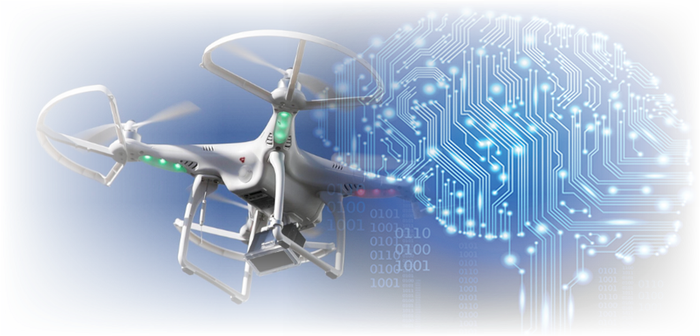Artificial Intelligence - the future of drones
Unmanned, aerial vehicles used for a variety of purposes are called drones. In the past, when they were first developed, drones were manually, remote controlled. Recently there has been a trend of incorporating artificial intelligence in drones to automate some or all of its operations.
With the help of artificial intelligence, drone vendors can use data collected from sensors attached to the drone to implement visual and environmental information. The desired information enables autonomous flight, easing operations and increases accessibility in remote areas. Drones have now become part of smart technology offerings that are available to businesses and consumers. Artificial Intelligence based drones use computer vision to work. This technology allows drones to analyse and record information on the ground and detect objects while flying.
Computer vision uses a neural network for high performance, onboard image processing. Algorithms in machine learning are implemented using the neural network which is a layered architecture.
Using neural networks the drones can perform classification, tracking and object detection. The data collected is combined in real-time to enable autonomous flights, to avoid collisions and locate / track targets.
Researchers first train machine learning algorithms to detect and classify assets in a wide variety of situations, then a neural network can be implemented in drones. Specially marked images are fed into the algorithm for machine learning to take place.
These types of images let the neural network know which properties classes of objects have and how to distinguish one type of object from another.
As the neural networks get more advanced, they can continue learning without supervision during operation, making detection and analysis much easier.
Sensors are the other important component for Artificial Intelligence based drones. Visual, positioning and environmental data are collected by the sensors and processed by the drone systems.
The drone can then respond to the data fed into the machine learning models in order to react to environmental conditions, to identify objects to prioritize or avoid and assess locations the drone can fly to. The sensor data can also be utilised after the drone has landed in non-flight related analysis.
There are many benefits that come with Artificial Intelligence drones.
In-flight real-time data streams can be processed using Artificial Intelligence. A continuous feedback loop is created for operators and internal systems which enable autonomous corrections of flight operations.
Applying data in real-time is especially useful when drones operate in areas that are unsafe or difficult for humans to reach. Artificial Intelligence allows drones to adapt to conditions that humans cannot. Operations such as adjusting to strong air currents by making high speed calculations or to capture data that might be omitted by human operators due to lack of light.
Artificial Intelligence based drones can be used to collect information on operating conditions and to measure the efficiency of operators.
Drones can operate more safely and efficiently by identifying the traits that are used in skillful operation. Difficult conditions can be simulated by Artificial Intelligence programs to teach operators how to prevent loss to equipment or damage to drones, improving purchaser return on investment.
Companies can use drones to monitor and scan assets continuously and autonomously. AI-based drones can enable companies to evaluate areas that are dangerous for humans. Evaluations can be done faster, conditions can be documented without the need to walk through sites or climb structures.
Artificial Intelligence is exactly what drones need to move into a cross-industries solution. Computer vision and advanced sensors allow Artificial Intelligence based drones to identify and react to their surroundings and assess them accordingly.
Artificial Intelligence based drones can also benefit from big data, enabling drones to adjust flight and adapt when changes occur through the use of AI. Collected data can be analysed to provide companies with the insight needed to improve products and services.

